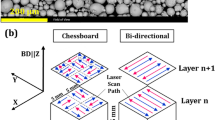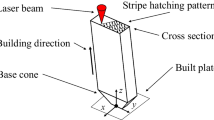Abstract
This paper investigates the dynamic compression behavior of Ti–6Al–4V alloy built through powder bed fusion (PBF) additive manufacturing. Samples of 45 different conditions were examined: Builds of three different orientations (vertical, horizontal, and 45° tilt), built in five different locations around the build plate (four corners and center), in as-built, stress-relieved and hot isostatically pressed conditions. High strain rate behavior was evaluated using a Split-Hopkinson Pressure Bar testing system. The as-built builds showed significant scatter with respect to both orientation and location owing to high internal stresses. Stress relief treatment resulted in a locationally uniform response but the retained columnar structure gave rise to higher strength in 45° tilt builds, along with a higher propensity for failure by shear localization. Hot isostatic pressing was found to be a necessary treatment for a truly homogeneous response that was independent of orientation and location on the build plate. A second series of samples were built in porous sandwich form with modification of processing parameters in the core to produce varying amounts of porosity. Porous samples exhibited greater energy absorption per unit volume than fully dense samples. Largest energy absorption capacity was observed in the samples with minimal porosity due to delayed failure without a significant loss in strength.














Similar content being viewed by others
References
Vilaro T (2011) As-fabricated and heat-treated microstructures of the Ti-6Al-4V alloy processed by selective laser melting. Metall Mater Trans A 42(10):3190–3199
Baufeld B (2011) Wire based additive layer manufacturing: comparison of microstructure and mechanical properties of Ti-6Al-4V components fabricated by laser-beam deposition and shaped metal deposition. J Mater Process Technol 211:1146–1158
Vrancken B (2012) Heat treatment of Ti6Al4V produced by selective laser melting: microstructure and mechanical properties. J Alloys Compd 541:177–185
Carroll BE (2015) Anisotropic tensile behavior of Ti–6Al–4V components fabricated with directed energy deposition additive manufacturing. Acta Mater 87:309–320
Wauthle R (2015) Effects of build orientation and heat treatment on the microstructure and mechanical properties of selective laser melted Ti6Al4V lattice structures. Addit Manuf 5:77–84
Palanivel S (2016) Spatially dependent properties in a laser additive manufactured Ti-6Al-4V component. Mater Sci Eng A 654:39–52
Lee W (1998) Plastic deformation and fracture behaviour of Ti–6Al–4V alloy loaded with high strain rate under various temperatures. Mater Sci Eng A 241(1):48–59
Biswas N (2012) Deformation and fracture behavior of laser processed dense and porous Ti6Al4V alloy under static and dynamic loading. Mater Sci Eng A 549:213–221
Valdez M (2017) Induced porosity in super alloy 718 through the laser additive manufacturing process: microstructure and mechanical properties. J Alloys Compd 725:757–764
Pattanayak D (2011) Fabrication of bioactive porous Ti metal with structure similar to human cancellous bone by selective laser melting. Bioceram Dev Appl. https://doi.org/10.4303/bda/D101206
Chen WW (2010) Split Hopkinson (Kolsky) bar: design, testing and applications. Springer, New York
Ahmed T (1998) Phase transformations during cooling in α + β titanium alloys. Mater Sci Eng A 243(1):206–211
Semiatin SL (1999) Flow behavior and globularization kinetics during hot working of Ti–6Al–4V with a colony alpha microstructure. Mater Sci Eng A 263(2):257–271
Lee D (2004) Dynamic deformation behavior and ballistic impact properties of Ti-6Al-4V alloy having equiaxed and bimodal microstructures. Metall Mater Trans A 35(10):3103–3112
Zuo JH (2008) Effect of microstructure on ultra-high cycle fatigue behavior of Ti–6Al–4V. Mater Sci Eng A 473(1):147–152
Lu SL (2015) Microstructure and mechanical properties of long Ti-6Al-4V rods additively manufactured by selective electron beam melting out of a deep powder bed and the effect of subsequent hot isostatic pressing. Metall Mater Trans A 46(9):3824–3834
Gangireddy S (2017) High temperature dynamic response of a Ti-6Al-4V alloy: a modified constitutive model for gradual phase transformation. J Dyn Behav Mater 3(4):557–574
Nemat-Nasser S, Guo WG, Nesterenko VF, Indrakanti SS, Gu YB (2001) Dynamic response of conventional and hot isostatically pressed Ti–6Al–4V alloys: experiments and modeling. Mech Mater 33(8):425–439
Gray III GT, Livescu V, Rigg PA, Trujillo CP, Cady CM, Chen SR, Carpenter JS, Lienert TJ, Fensin SJ (2017) Structure/property (constitutive and spallation response) of additively manufactured 316L stainless steel. Acta Mater 138:140–149
Al-Bermani SS (2010) The origin of microstructural diversity, texture, and mechanical properties in electron beam melted Ti-6Al-4V. Metall Mater Trans A 41(13):3422–3434
Seo S (2005) Constitutive equation for Ti–6Al–4V at high temperatures measured using the SHPB technique. Int J Impact Eng 31(6):735–754
Jones DR, Fensin SJ, Dippo O, Beal RA, Livescu V, Martinez DT, Trujillo CP, Florando JN, Kumar M, Gray GT III (2016) Spall fracture in additive manufactured Ti-6Al-4V. J Appl Phys 120(13):135902
Timothy SP (1987) The structure of adiabatic shear bands in metals: a critical review. Acta Metall 35(2):301–306
Timothy SP (1985) The structure of adiabatic shear bands in a titanium alloy. Acta Metall 33(4):667–676
Rogers H (1974) Adiabatic shearing: a review. USA Army Research Office, Drexel University, Philadelphia, PA
Dormeval R (1987) The adiabatic shear phenomenon. Elsevier, London
Ashby MF (2000) Metal foams: a design guide, Chap. 4. Elsevier, London, pp 53–55
Acknowledgements
The work was performed under a cooperative agreement between the Army Research Laboratory and the University of North Texas (W911NF-16-2-0189). We also acknowledge the Materials Research Facility at UNT for microscopy facilities.
Author information
Authors and Affiliations
Corresponding author
Rights and permissions
About this article
Cite this article
Gangireddy, S., Faierson, E.J. & Mishra, R.S. Influences of Post-processing, Location, Orientation, and Induced Porosity on the Dynamic Compression Behavior of Ti–6Al–4V Alloy Built Through Additive Manufacturing. J. dynamic behavior mater. 4, 441–451 (2018). https://doi.org/10.1007/s40870-018-0157-3
Received:
Accepted:
Published:
Issue Date:
DOI: https://doi.org/10.1007/s40870-018-0157-3




